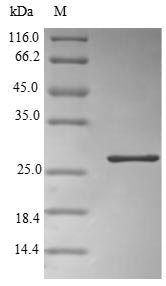This recombinant Human ORM2 protein is an E.coli expressed protein (Full Length of Mature Protein) with N-terminal 6xHis tag and its purity is 90%+ determined by SDS-PAGE. With the appropriate cDNA and PCR methods, ORM2 expression plasmids can be rapidly produced. which must undergo denaturation and folding cycle, can be recovered with more modest yields. Hence, using small-scale fermentations and laboratory-scale processing equipment, ORM2 proteins (or subdomains thereof) can usually be produced in sufficient quantities to initiate most studies including detailed structural determinations.which must undergo denaturation and folding cycle, can be recovered with more modest yields. Hence, using small-scale fermentations and laboratory-scale processing equipment, ORM2 proteins (or subdomains thereof) can usually be produced in sufficient quantities to initiate most studies including detailed structural determinations.
ORM2, an acute-phase protein, is predominately produced by the liver in response to the systemic reaction to inflammation and is then secreted in plasma. It can act as an anti-inflammatory and immunoregulatory factor because of its anti-neutrophil and anti-complement activity. ORM2 is linked to intestinal system diseases and cancers. Studies have shown that ORM2 may be involved in tumor metastasis and progression. ORM2 is considered an ideal biomarker for cholangiocarcinoma in combination with kinesin 18A.






